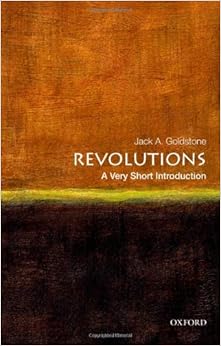Sunday, December 21, 2014
Book Review: Revolutions: A Very Short Introduction by Jack A. Goldstone
Jack A. Goldstone's book Revolutions: A Very Short Introduction examines the nature, causes and trajectory of revolutions. The first half of the book generalizes about revolutions while the second half is a series of case studies, from stirrings in ancient history to the Arab Spring revolts.
Goldstone opens the book with a discussion of what revolutions are. There are two narratives of revolutions, one which holds they are processes in which "downtrodden masses are raised up by leaders who guide them in overthrowing unjust rulers," and the other which maintains they are "eruptions of popular anger that produce chaos." (1-2) The reality, Goldstone argues, is that revolutions are both. Ultimately he settles on a definition of revolution as "the forcible overthrow of a government through mass mobilization (whether military or civilian or both) in the name of social justice, to create new political institutions." (4) He then lists many circumstances which are not, by themselves, revolutions: peasant revolts, grain riots, strikes, reform movements, coups, radical social movements, civil wars, rebellions, uprisings, insurrections and guerrilla warfare.
In the subsequent chapter Goldstone answers the question of what causes revolution. First he dismisses conditions that do not by themselves cause revolution: poverty (revolutions occur more often in middle-income countries), modernization, and new ideologies. He then names five conditions that he considers necessary and sufficient for revolution: 1) national economic or fiscal strains 2) growing alienation and opposition among the elites 3) increasingly widespread popular anger at injustice 4) an ideology that presents a shared narrative of resistance 5) favorable international relations. Goldstone maintains that, like an earthquake, revolutions are very hard to predict, even if one knows fault lines where one is likely to occur. He draws a distinction between common structural causes of revolution -- demographic change, a shift in the pattern of international relations, uneven or dependent economic development, new patterns of exclusion or domination against particular groups, the evolution of a personalist regime -- and common transient causes: food price spikes, defeat in war, riots, etc.
Chapter three examines the process of revolution. Revolutions usually progress through a series of steps: stake breakdown (which can come in the form of a central collapse, peripheral advance or negotiated revolution), postrevolutionary power struggles which see splits between moderates and radicals -- or even counterrevolution, institutionalization of the revolutionary regime, and sometimes a second radical phase years after the initial revolution led by radicals who feel that the revolutionary aims have not been obtained (e.g. the Cultural Revolution). To be successful, revolutionaries must have both visionary leadership and organizational leadership. Goldstone also enumerates a set of principles regarding revolutionary outcomes: outcomes do not emerge quickly, they depend on the type of revolution (social / anticolonial / democratizing), they are likely to lead to democracy in countries that have previous experience with it, and women's issues tend to not get much attention in the new regime.
The next several chapters give brief case studies of revolutions, from ancient to modern. Revolutions were quite frequent in the ancient world (including attempts by "history's first socialists" (45)) before becoming unlikely under emperors and kings (1CE - 1200CE). Revolutions picked up again after that (Goldstone mentions the Bonfire of the Vanities), progressing from constitutional revolutions to communist revolutions to color revolutions and the Arab Spring.
The final chapter has Goldstone mentioning sub-Saharan Africa as a region where the conditions for revolution are building because of demographic change. He also offers the Middle East as potentially revolutionary when key resources run out, as well as China.
Goldstone seems to hold a pretty expansive definition of what a revolution is, something like "a change in power through non-formal means that wasn't a military coup." I would say that the word "revolution" refers to what he calls "social revolutions" -- namely, a Goldstone revolution plus the construction of a new socio-political order. Goldstone also seems to have a preference for formal democracy and free markets as a social order, and seems to harbor a historical teleology pushing in that direction: "Someday, all countries in the world will have stable, resilient, inclusive and just regimes." (133) He also makes some claims that I found questionable. One is that revolutions generally shortchange women. While this may be true in general, I would think restricting the definition of revolution to social revolution might make that claim less true. The Russian Revolution, for instance, immediately instituted "Western feminism's maximum program, to which no government in the West ever came close to agreeing." (Geoff Eley, Forging Democracy, 188) Lastly, Goldstone makes the claim that the end of the Cold War reduced the willingness of the US and others to support unpopular regimes. The Cold War may have ended, but this dynamic seems pretty stable (the US's support of authoritarian Arab states, for instance). All in all, Goldstone's book provides a useful centrist overview of the nature of revolutions.
Subscribe to:
Post Comments (Atom)

No comments:
Post a Comment